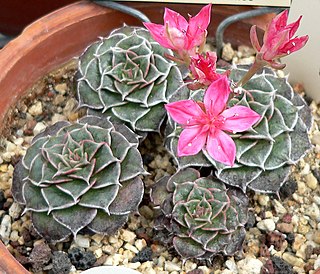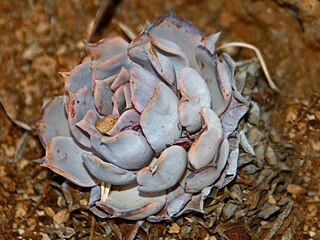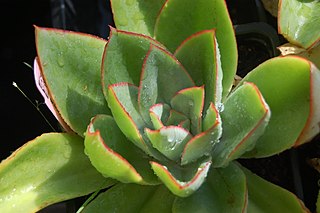
Echeveria is a large genus of flowering plants in the family Crassulaceae, native to semi-desert areas of Central America, Mexico and northwestern South America.

Dudleya, commonly known as liveforevers is a genus of rosette-forming succulent plants in the stonecrop family, Crassulaceae, consisting of about 68 taxa in southwestern North America and Guadalupe Island. The species come in many forms, some large and evergreen, others geophytic and deciduous. Yet, despite their dramatic variations in appearance, most species readily hybridize. The flowers of Dudleya have parts numbered in fives, with the petals arranged in tubular, star-shaped, and bell-shaped forms and, when fruiting, are filled with tiny, ovoid-crescent-shaped seeds.

Graptopetalum bellum is a species of flowering plant in the stonecrop family Crassulaceae, native to northern Mexico. It was discovered by Alfred Lau in 1972 in the states of Chihuahua and Sonora, at an altitude of 1,460 m (4,800 ft).

Echeveria setosa, the Mexican fire cracker, is a species of flowering plant in the family Crassulaceae, native to semi-desert areas of Mexico and common throughout Puebla.

Echeveria elegans, the Mexican snow ball, God's Throne, Mexican gem or white Mexican rose is a species of flowering plant in the family Crassulaceae, native to semi-desert habitats in Mexico.

Echeveria agavoides, or 'lipstick' echeveria, is a species of succulent flowering plant of the stonecrop (sedum) family Crassulaceae, native to the rocky canyons and arid hillsides of Central Mexico. It is primarily known from the states of Aguascalientes, Durango, Guanajuato, Hidalgo, Jalisco, Querétaro, San Luis Potosí and Zacatecas, though it has been sighted as far north as Coahuila and as far south as Oaxaca.

Echeveria lilacina, common name ghost echeveria or Mexican hens and chicks, is a species of succulent plants in the genus Echeveria belonging to the family Crassulaceae.

Echeveria runyonii is a species of flowering plant in the family Crassulaceae, that is native to the state of Tamaulipas in Mexico. Several cultivars have been described and cultivated.

Echeveria desmetiana, incorrectly known as Echeveria peacockii, is a succulent plant in the family Crassulaceae. L. de Smet was the first grower of this plant.

Echeveria derenbergii, the painted-lady, is a species of flowering plant in the family Crassulaceae, endemic to Mexico.

Echeveria strictiflora, the desert savior, is a species of flowering plant in the family Crassulaceae, native to southwestern Texas and to the Chihuahuan Desert of northeast Mexico. Its range consists of several scattered populations, rather than a contiguous range.

Echeveria gibbiflora is a species of flowering plant in the family Crassulaceae. It was described by Swiss botanist Augustin Pyramus de Candolle in 1828. It occurs in Mexico and Guatemala.

Echeveria subrigida is a species of succulent plant native to Mexico. It was first formally described in 1903 by Benjamin Lincoln Robinson and Henry Eliason Seaton. Its basionym is Cotyledon subrigida.

Echeveria atropurpurea is a species of succulent plant in the Crassulaceae family. It is a perennial commonly known as chapetona or siempreviva, and is a endemic to Central Veracruz, Mexico in tropical deciduous forests. It is noted for its fast growing, easy cultivation, and red to yellow flowers. It is currently threatened by habitat loss.

Echeveria amoena is a species of succulent plant in the family Crassulaceae, endemic to semi-arid areas of the Mexican states of Puebla, Tlaxcala, and Veracruz.

Echeveria chihuahuaensis, sometimes Echeveria chihuahuensis, is a species of perennial flowering plant in the family Crassulaceae. It is native to Mexico. It is a diploid species, with a chromosome count of 50.

Echeveria xichuensis is a succulent species of flowering plant in the family Crassulaceae, endemic to Xichú, Guanajuato, Mexico.

Echeveria minima, the miniatureecheveria, is a species of succulent flowering plant in the stonecrop (sedum) family,Crassulaceae, native to northeastern Mexico. Among the many Echeveria species and cultivars, Echeveria minima, in particular, has rather small and diminutive, light-teal blue rosettes edged with pink leaf margins. The attractive, "artichoke"-like rosettes eventually produce enough offsets that they grow into a small colony, forming a low mound. Echeveria minima readily produces yellow, bell-shaped flowers on vertical inflorescences in the spring. A highly collectible succulent, it has gained the Royal Horticultural Society's Award of Garden Merit.

Echeveria shaviana, called Mexican hens or Mexican hens and chicks, is a species of flowering plant in the family Crassulaceae, native to northeastern Mexico. A succulent, it has gained the Royal Horticultural Society's Award of Garden Merit.
Reidmorania occidentalis is a succulent plant in the stonecrop family (Crassulaceae) native to the state of Sinaloa in Mexico. It is within the monotypic genus Reidmorania, which is named after botanist Reid Moran, who was notable for his research in the Crassulaceae family.




















